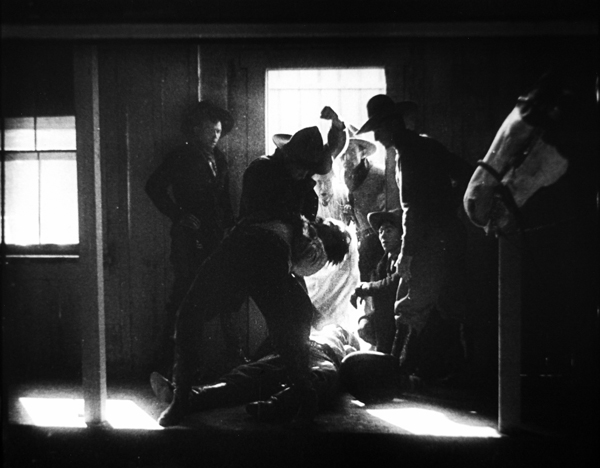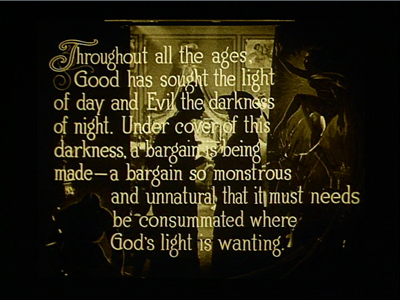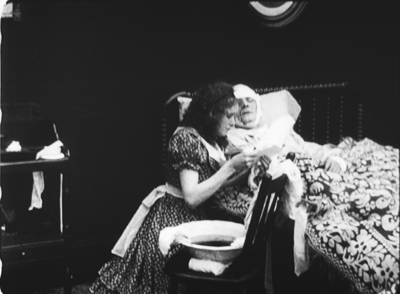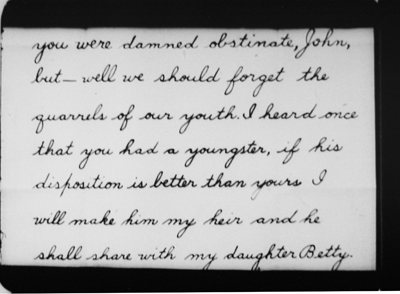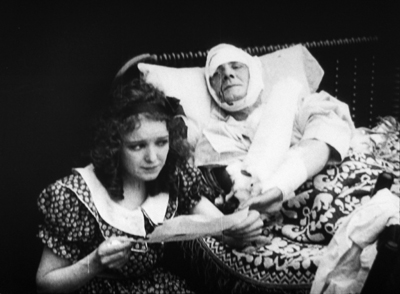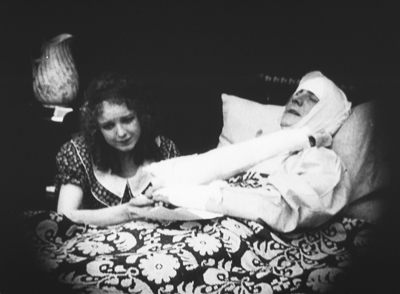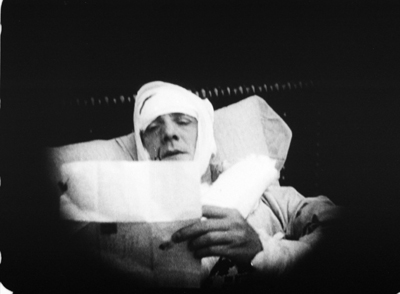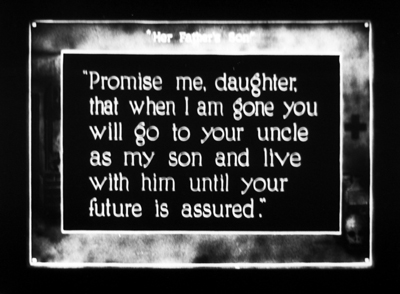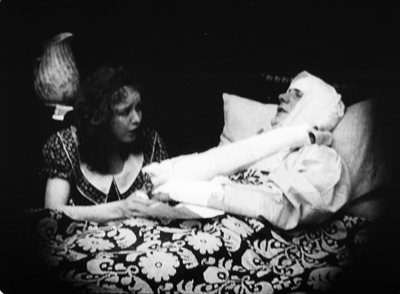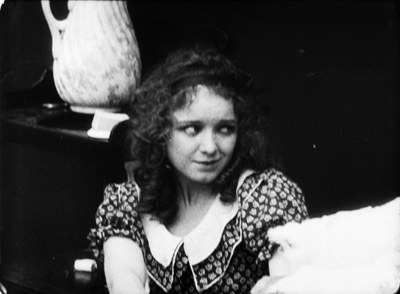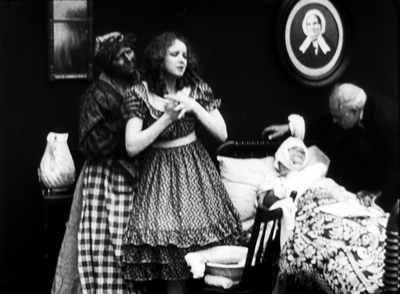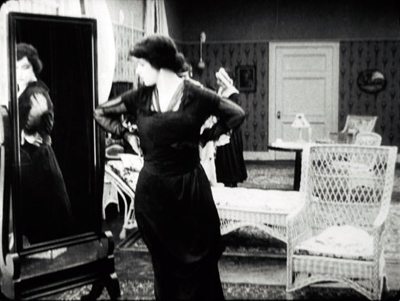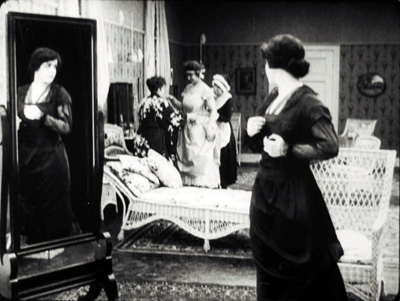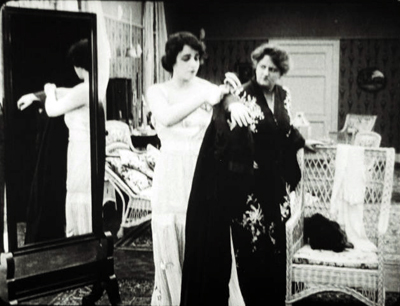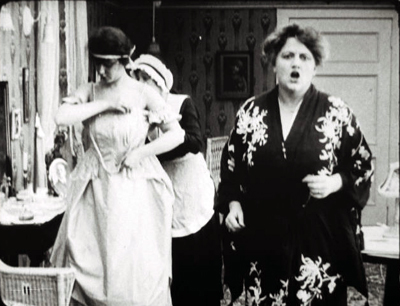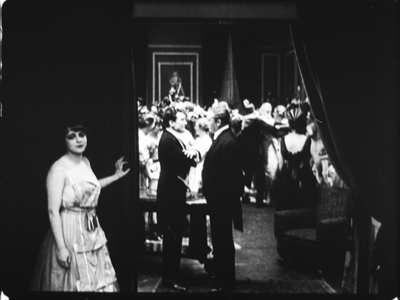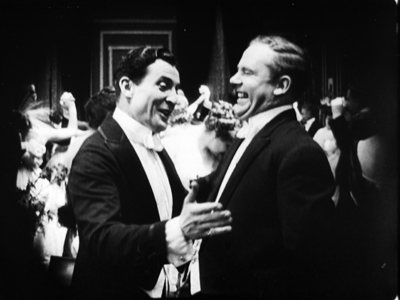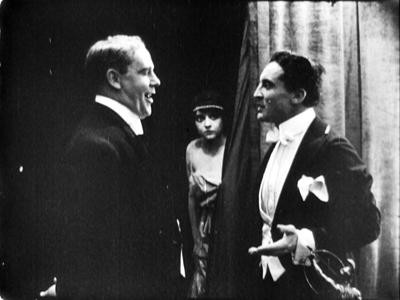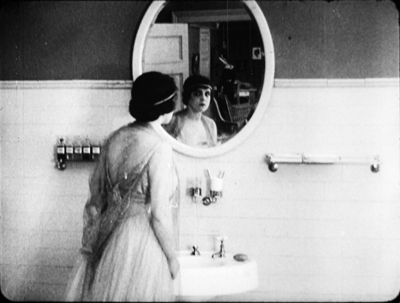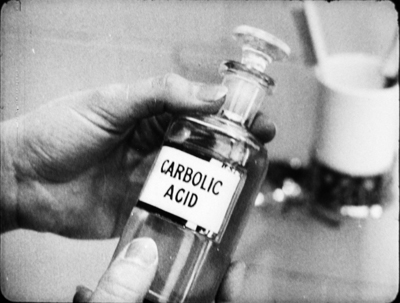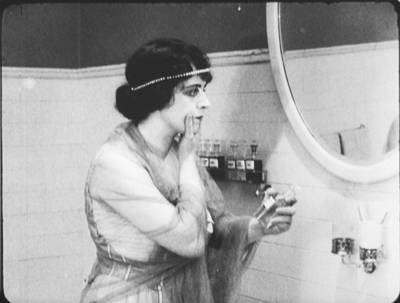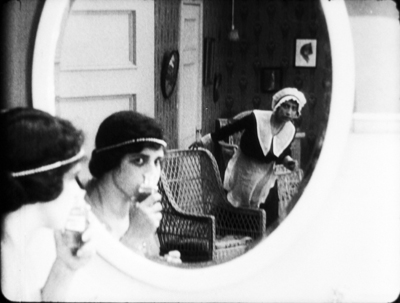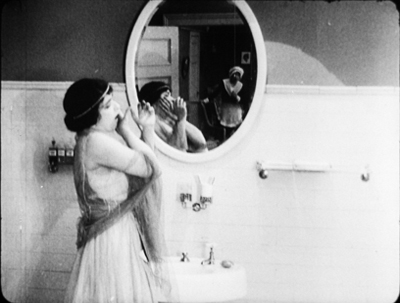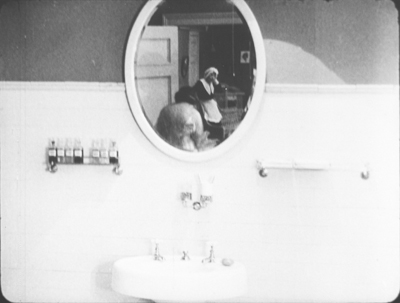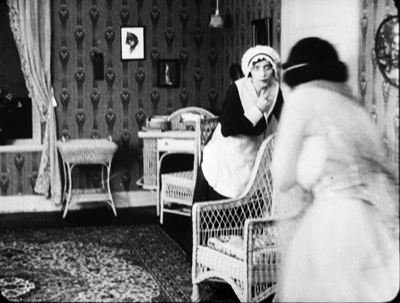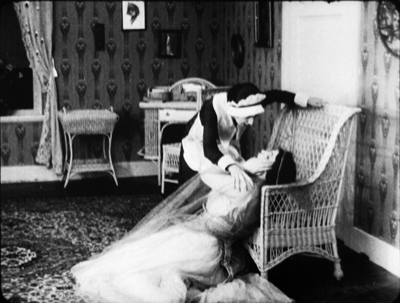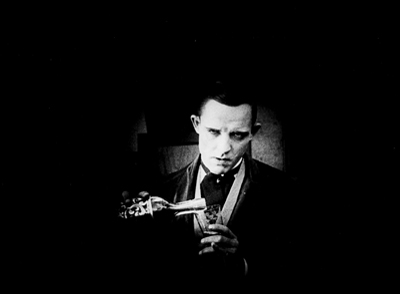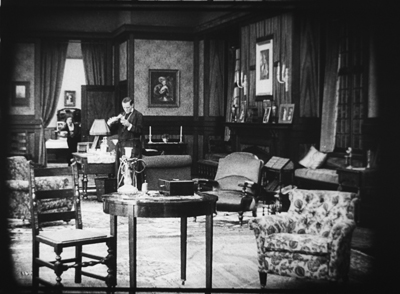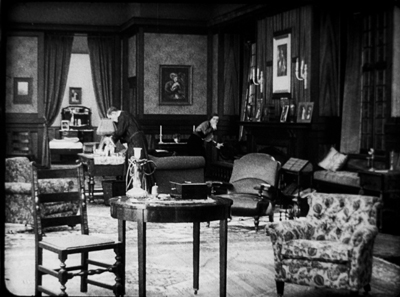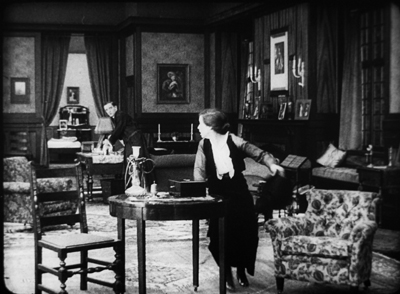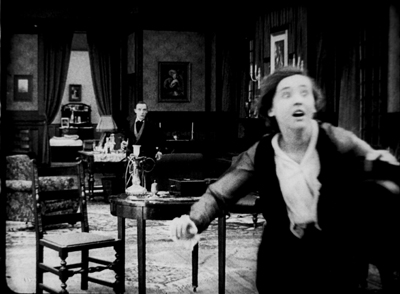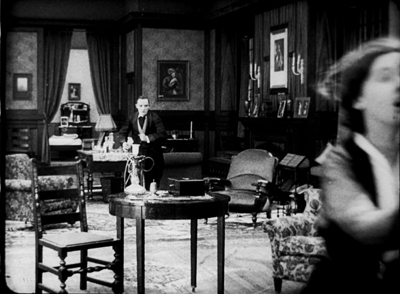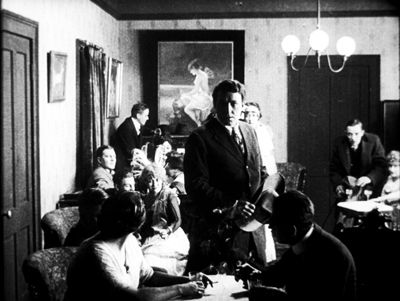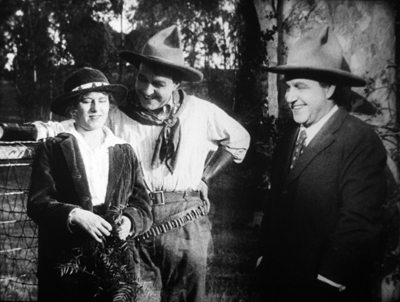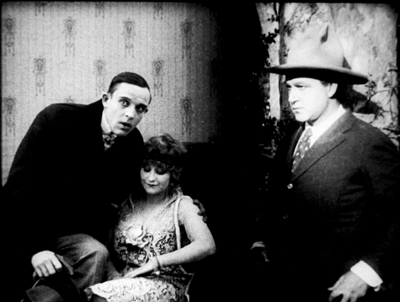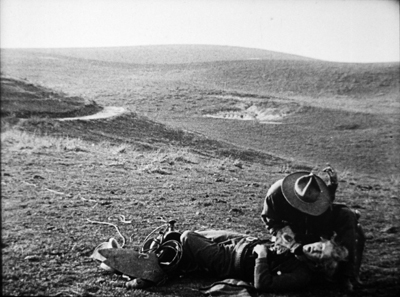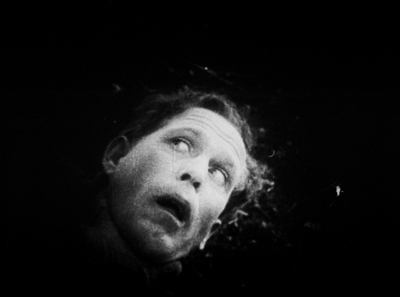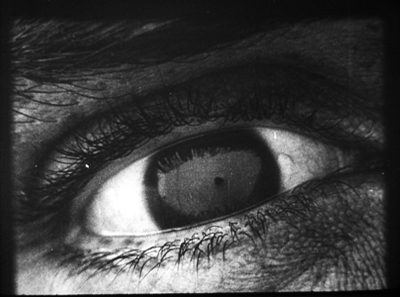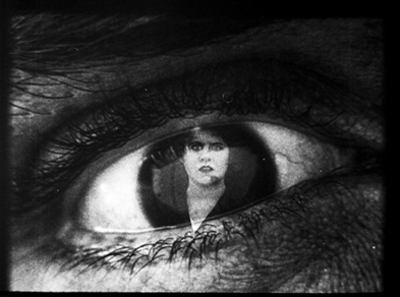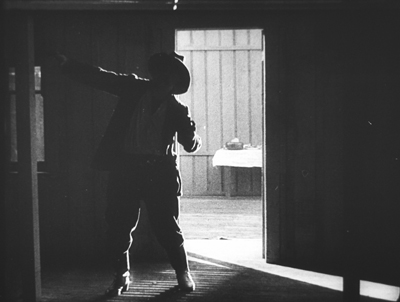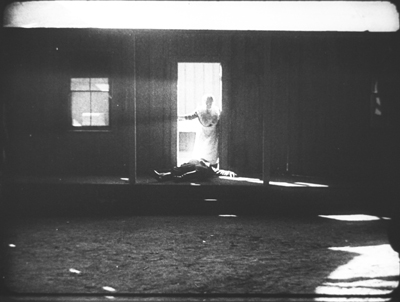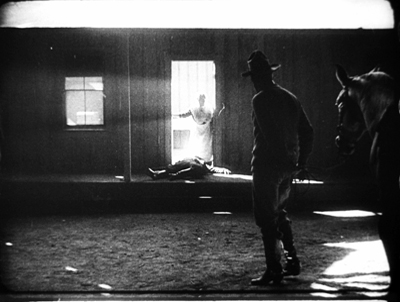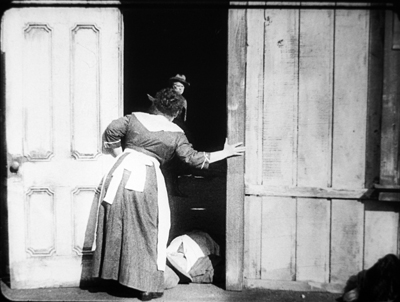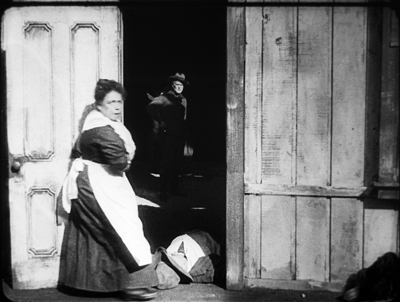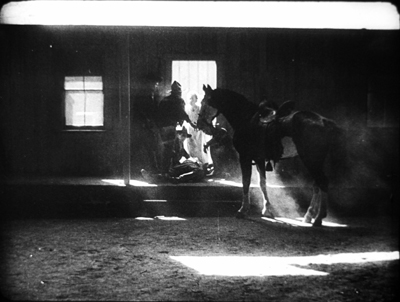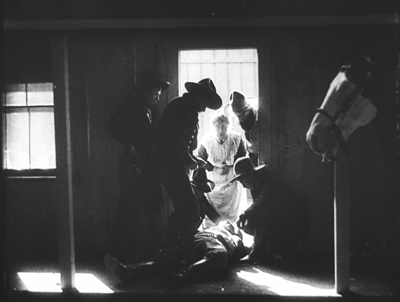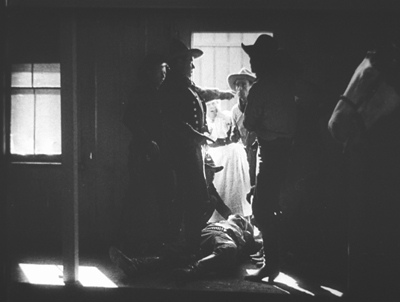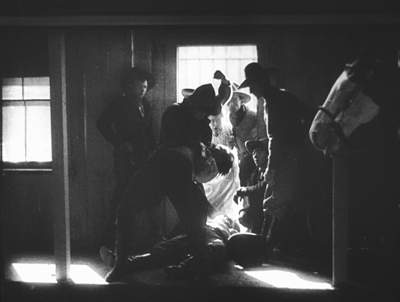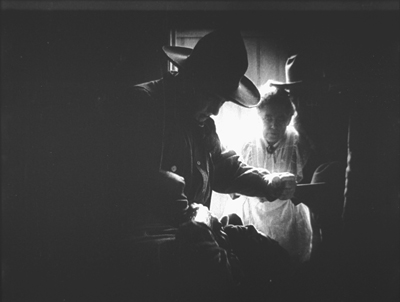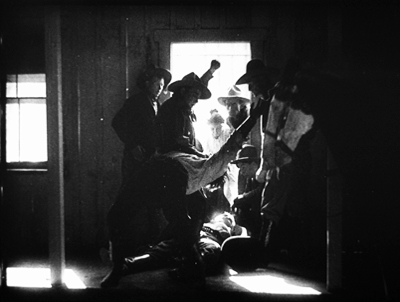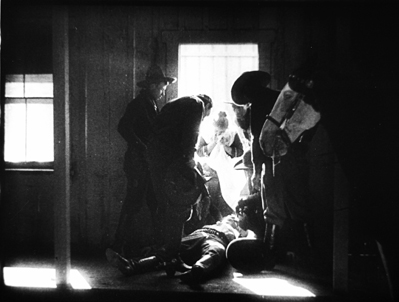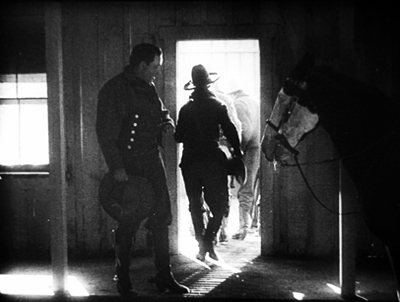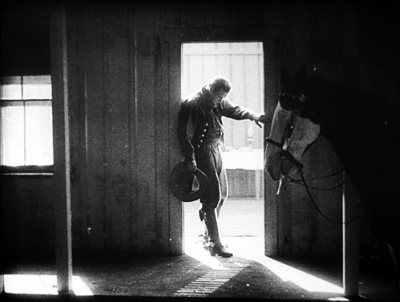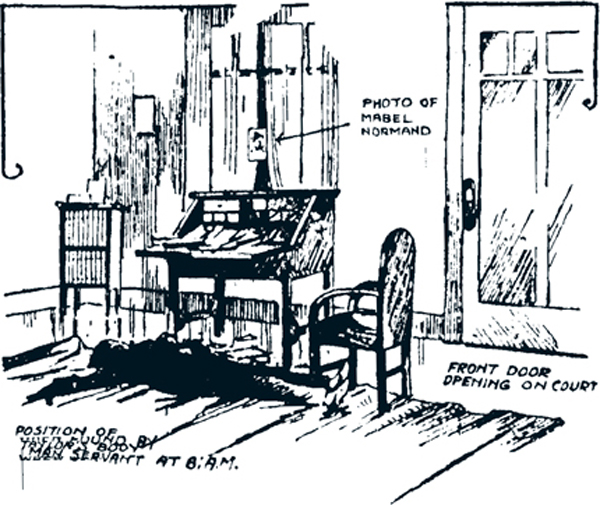When we dead awaken: William Desmond Taylor made movies too
Monday | May 1, 2017 open printable version
open printable version
Ben Blair (1916).
DB here:
It wasn’t until they turned the body over that they realized he had been shot. By then, the crime scene had become chaos. Studio employees swarmed over the bungalow and swiped incriminating letters, while neighbors and reporters drifted in freely. The police left their own fingerprints around the place. No wonder the case remains unsolved.
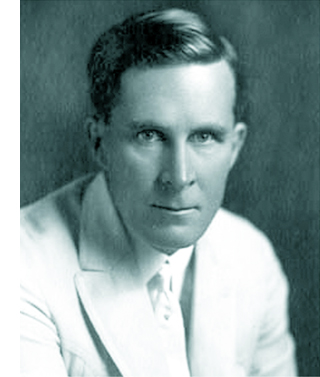 William Desmond Taylor’s place in film history is secure, but not because of his movies. His 1922 murder galvanized the nation. Suspects included stars Mabel Normand and Mary Miles Minter, Minter’s mother, an embezzler, an estranged brother, bootleggers, drug pushers, blackmailers, and assorted low-lifes. The case reeked deliciously of scandal.
William Desmond Taylor’s place in film history is secure, but not because of his movies. His 1922 murder galvanized the nation. Suspects included stars Mabel Normand and Mary Miles Minter, Minter’s mother, an embezzler, an estranged brother, bootleggers, drug pushers, blackmailers, and assorted low-lifes. The case reeked deliciously of scandal.
Minter was infatuated with him, her mother owned a .38, and Taylor’s secretary had absconded with a car and forged checks. Speculation spread in many directions. Was Taylor gay or bisexual? Was he a drug addict, or a supplier, or someone trying to rescue a friend from addiction? Did Mary and Mabel quarrel over his affections? Who was his late-night male visitor? Did the bungalow actually contain tagged items of ladies’ lingerie, and pornographic photos of Taylor cavorting with starlets?
For nearly a hundred years fans and tabloid TV have returned obsessively to the murder. Even King Vidor began sleuthing late in life with the aid of Colleen Moore.
Taylor cut quite the figure. Tall, handsome, and solemn of mien, he left Ireland and led a barnstorming life in America. He abandoned a wife and daughter in New York to take up touring stage work. He wound up in Hollywood. After some acting successes, he directed shorts before graduating to the popular serial The Diamond from the Sky (1915). His feature films were widely respected, and he became a key figure in forming the Directors Guild (then the Motion Picture Directors’ Association).
Okay, it makes a swell mystery. But what about Taylor’s movies?
The other sort of teenpix
Back in 1976, Richard Koszarski had the very good idea of mounting a program called The Rivals of D. W. Griffith for the Walker Art Center. Auteurism was at its height, so it’s no surprise that the program’s subtitle was Alternative Auteurs: 1913-1918.
Remember, this was before all those festivals that today specialize in exhuming silent classics. Beta and VHS had just been introduced and were not yet popular. There was no Criterion, Flicker Alley, or TCM, or any other platform that would give these old movies a mass-market afterlife.
Since then, things have improved a lot. We can now see on video nearly everything in Richard’s show: Wild and Woolly, Stella Maris, Juve vs. Fantômas, The Italian, Hell’s Hinges, The Mysterious X, Straight Shooting, The Gun Woman, Behind the Screen, The Rink, The Immigrant, The Outlaw and His Wife, The Cheat, and The Blue Bird. Some of the copies are shabby, but they’re out there. Anyhow, collectors’ 16mm dupes that circulated back in the day were hardly impeccable.
The program helped balance out historical accounts. Richard’s opening essay in the program’s catalogue flung down the challenge. Most historians had ignored the period, but:
Even the most casual investigation must reveal the years 1913-18 as the most hectic, tumultuous and progressive in the entire history of the cinema.
Richard’s aim wasn’t to attack Griffith. This was a time when cinephiles were discovering the superb Biograph shorts, and appreciation of his artistry was expanding. Instead, Richard usefully reminded us of all the other things going on as features emerged.
Looking at the films in this program will help anyone appreciate even more fully Griffith’s strengths, and pinpoint more certainly his weaknesses. Often his individual achievements will be matched, sometimes surpassed.
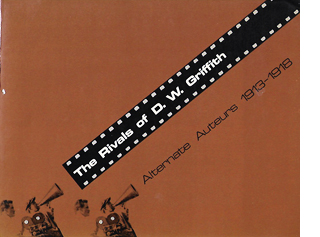 Richard’s introduction ably sums up the changes in the industry that made the period so fertile. And the contributors’ notes that follow, while brief, point up valuable things about the program. The Rivals of D. W. Griffith is still very much worth having.
Richard’s introduction ably sums up the changes in the industry that made the period so fertile. And the contributors’ notes that follow, while brief, point up valuable things about the program. The Rivals of D. W. Griffith is still very much worth having.
My recent investigation of nearly a hundred U.S. features from the period wasn’t exactly casual, but it seems merely a depth sounding of a vast body of extraordinary work. I’ve offered you glimpses of it in earlier entries (here and here and here), but there’s a lot more I’d like to share.
Which brings me back to William Desmond Taylor. He doesn’t figure in Richard’s Rivals show, probably because few of his films were available. Most of his work is lost. He signed forty features between 1915 and 1922, of which seventeen apparently survive, many incomplete. Most of those I’ve seen are solid but not dazzling. The amiable Tom Sawyer (1917) is a good example of how polished Hollywood cinema already was in 1917, and the leisurely Mary Pickford item Johanna Enlists (1918) is ingratiating as well. At the film’s climax Taylor tries for triangular staging of the type that would come in the 1920s, but he botches it with mismatched eyelines and screen directions. By the time of The Soul of Youth (1920), a touching movie about juvenile delinquency, the cutting is very meticulous, as in Huckleberry Finn (1920). Both films use startlingly tight close-ups, some of them shot with a wide-angle lens.
Taylor also claimed innovations in visual narration. His now-lost Sacred and Profane Love (1921) was promoted as including scenes in which an expository title rises up over character action, makes its comment, and melts away while the scene continues. Perhaps the opening of The Soul of Youth was a step in this direction. In chiseled silhouettes we see an unwed mother selling her baby to a gangster’s girlfriend, introduced through “art titles” dissolving away to reveal the action.
The Soul of Youth also includes some embedded scene movement in the corners of titles. Such experimentation with intertitles was a trend of the period.
So we have a director of some ambition. That inference is backed up by some flashy moments in earlier 1910s work. In 1916 Taylor released a remarkable nine features, and during my DC stay I saw what remains of four of them. Although they’re in parlous shape, they show a lively pictorial and dramatic intelligence. Are they auteur films in the strong sense? At least we can say that Taylor, like many other directors, was channeling just that exuberant creative energy that Richard evokes. Certain moments in two of these movies have genuine flair, and one film is an all-out stunner. I had never heard of any of them.
1916 and all that
My first 1916 title is Pasquale. It stars George Bevan, famous for his stage roles as good-natured Italians. It’s a story of friendship betrayed. Two immigrants who return home to fight for Italy are shown to be more honorable than the American men who cheat them and beat their women.
“A mighty good feature,” said Variety’s reviewer, but you can’t prove it by me. The Library of Congress print lacked the first and last reels, and what was in between consisted of scenes and parts of scenes jumbled up. While it’s certainly competent, I didn’t see much subtlety in its staging or cutting. The use of crosscutting to tie together its story lines was standard for the period.
The print of the Civil War story Her Father’s Son was a little scrambled too, and it lacked the final reel, but it was more coherent. A girl from the North must pretend to be a boy—first, to satisfy an old Southerner’s urge for an heir, then after the war starts she is pressed into service as a courier, and eventually a sterling supporter of the confederacy. The most noteworthy bit of technique, I thought, involved the varied camera setups in one scene. Frances (Vivian Martin) is asked by her dying father to go live with his brother as a boy. The changes in shot scale and angle emphasize her moment of decision, as well as her reaction to her father’s death.
This passage shows more flexibility of camera setup than Griffith displays in the sequences in the Union hospital in The Birth of a Nation (1915), or in Intolerance, from the same year as Taylor’s film. Taylor here joins a general push toward finer-grained analytical editing in dialogue scenes. Other examples are Reginald Barker’s The Bargain (1914) and DeMille’s The Cheat (1915).
The House of Lies is more flamboyant and peculiar. Edna is an ethereal girl who likes waterfalls, poetry, children, and rabbits. Her stepsister Dorothy is vain and soulless. Mrs. Coleman is determined to marry both off to wealthy men. Refusing to trade her beauty for social position, Edna splashes her face with acid. She becomes the secretary of the sensitive author Marcus Auriel. But the stepmother is plotting to snare him for Dorothy, while also joining forces with a thief who wants to steal a financial document from Auriel’s safe.
Variety considered The House of Lies a good example of “what a feature picture should not be.” The reviewer considered it old-fashioned melodrama. Fair enough, but it doesn’t creak much and has considerable visual fluency. Sometimes there are echoes of the tableau style, as when Edna steps aside to reveal her sister and stepmother dressing in the background.
But the same tableau setup gets overridden by the sort of axial cut so common at the period. Earlier in the scene when the stepsisters get dressed for the big party at which they’ll be displayed, instead of letting Dorothy step aside to reveal the other women, Taylor “cuts through” Edna’s blocking figure to the women behind her.
The transition would be jumpy were it not for a (mispunctuated) title: “I don’t understand all this display mother; when we should still be in mourning for father.”
A variant of the axial cut employs a 180-degree reversal. We’ve already seen Edna’s reluctance to enter “the auction” at which rich men will look her and Dorothy over. She pauses at the doorway, which in wealthy houses of this period always seem to be covered with a heavy curtain.
Later, after her mother has taken Dorothy around to meet her guests, we see the poet Auriel remark to a friend that it’s like a modern slave market. Cut to the opposite side of the men to reveal Edna’s reaction to his line.
It’s this that drives her upstairs to destroy her beauty.
The acid-splashing is of course the grisly high point of this drama. It’s handled with what at first seems a tactful obliqueness.
Mrs. Coleman has summoned a maid to bring Edna back to the gathering. As she enters, Edna stands at the mirror, pondering. Since Dorothy is the sister associated with mirrors, this seems out of character for Edna.
Seeing the maid, she picks up the bottle of acid. Before opening it, she experimentally rubs her face.
A closer view of her at the mirror shows her ostentatiously lifting the bottle, as if making sure the maid sees it. In retrospect, it may be that she’s staging the scene for an eyewitness.
Cut back to the original bathroom framing as Edna seizes her cheek and cries out. She runs into the next room, as seen in the reflection.
A nice match on action brings Edna into the boudoir, where she collapses.
Thereafter Edna sports a ravaged cheek or a discreet bandage. Eventually Auriel declares that he loves her despite her deformity. She then reveals that her scar is mere makeup. She never really applied the acid. She wanted out of the marriage auction and sought someone to love her for herself.
Taylor’s framing and cutting conspire with Edna to conceal her deception. Mirrors create spatial trickery in 1910s films from both America and Europe, often doing duty for reverse angles or POV cutting. The embedded image usually serves to expand what we know, as it does here.
But Taylor’s mirror reflection also makes the maid into a decoy, teasing us to watch her as well as Edna. Hiding what Edna was up to would have been more obvious if we didn’t have the maid to distract us. Of course Taylor could simply have cut away from Edna at the crucial moment, but that wouldn’t carry as much conviction as seeing an apparently full, if discreet, shot of the self-mutilation.
A noir western?
Noirish westerns like Duel in the Sun (1947), Pursued (1947), and The Furies (1950) revolve around dysfunctional families, tyrannical patriarchs, childhood anguish, and sadistic corruption. Somewhat in this vein is one of the story lines that inform Taylor’s Ben Blair (1916). The noirish action is embedded within a larger plot involving the clash of New York decadence and prairie rectitude. As a bonus, certain scenes evoke that proto-noir style I considered in an earlier entry. One scene of violence is spectacularly beautiful—Ford meets Mann, shall we say, before both showed up.
The film roughly follows the plot of the 1905 novel. When Tom Blair’s common-law wife dies of illness and neglect, he sets fire to his ranch house in an effort to destroy her corpse and kill her son Ben. The boy escapes and is adopted by the good-hearted rancher Rankin. Ben grows up alongside Florence, daughter of another rancher. When Flo’s father dies, his widow takes Flo to New York in search of a husband for her. In the meantime, Tom Blair has returned and is raiding local ranches for horses. He shoots Rankin, and Ben sets out to avenge both his mother and his benefactor.
The second half of the novel, and the film, brings Ben to New York. He finds Flo captivated by the urbane but unstable Clarence Sidwell. After Ben sees the depravity of city life, he tries to lure Flo away.
Second things first. Critics found the New York section of the book less evocative than the Western half, but such can’t be said for the film. An eyebrow-raising introduction to the rake Sidwell leaves little to the imagination.
Flo had told Ben she wanted to leave the West for “the things of civilization.” Now we get a title: “The things of civilization. Exhibit 1: Clarence Sidwell.” Fade in on a louche creature pouring himself a drink.
Shock cut back: In an extreme long-shot, a young woman bursts out from the distant bedroom, dodges Sidwell, zigzags desperately through the vast parlor, and hurls herself out of the foreground.
As the deep space of 1910s cinema becomes an obstacle course, we’re obliged to understand that the poor woman has been raped. The power of the scene comes from her frantic rush toward us in contrast with Sidwell’s bored calm.
When she collapses in the next room, he moves as if to follow her, then shrugs and returns to his post-coital drink. In the novel, Sidwell is a neurotic workaholic, nothing like this chilling libertine.
A parallel scene occurs later, when Ben has come to Manhattan to visit Flo. On the street at night, he chivalrously agrees to see a woman to her apartment, only to find that he’s been tricked into visiting a brothel.
As in the novel, he shoots his way out (these sissies can’t handle him), but not before he glimpses Sidwell there with a floozy. This, along with Sidwell’s rape of the woman we’ve already seen, reminds you of what all those censors were complaining about in the era of scandals around Fatty Arbuckle, Wallace Reid, and other Taylor contemporaries.
Ben learns that Flo has agreed to marry Sidwell, and Ben’s memory compares the brothel revelation with Flo’s farewell to him back on the ranch.
He must save her from this man.
Ben is too honorable to snitch on Sidwell. He simply walks in the family mansion and tells Flo that she is leaving with him in half an hour, or he will kill Sidwell. He counts on her underlying love for him and their childhood home. After her indignation dies down, she agrees happily to go “back to God’s country.”
The tension of the film’s first half centers on Tom Blair’s murder of the genial old Raskin and Ben’s pursuit of Blair. Tom, it turns out, isn’t Ben’s biological father; Raskin is. Tom has killed Ben’s mother through abuse and his natural father through homicide, so the son’s quest gains mythical overtones.
There are some majestic vistas, along with flashy exchanges of gunfire among rocks. The clincher comes when at the height of their fistfight, Ben is ready to strangle Tom and bends over him. The false father gasps for mercy.
A brutal cut takes us to Ben’s eye, which fills with the image of Florence.
We realize that he couldn’t face Flo if he murdered a man in cold blood. So he lets Tom live, drags him back to town, and even saves him from a lynch mob. But this moment—in 1916, remember—shows how eager filmmakers of this period were to maximize the emotional power of a scene. Often we’ll find that an expository title and a bit of facial emoting has been replaced by tactics of cutting, framing, and here, precise special effects.
Devil’s doorway
Skilful backlighting is more precious than a gallon of peroxide!
William Desmond Taylor
This isn’t the film’s only prefiguration of the noir hero driven to the brink. Ben has nearly lost control earlier in the film, and this scene involves the noir look as well. It grows out of Tom Blair’s cold-blooded murder of Raskin.
In the novel, Ben witnesses it from the barn, but he’s too late to catch Tom before he rides off. In the film, Ben is in town, seeing off Flo and her mother at the train. Now the scene is played out for us, with the cook as an appalled side participant.
Hearing noise in the corral, Raskin steps out on the porch. The edge lighting outlines him vividly enough to be visible, and cut down.
A 180-degree reverse shot puts us inside as the cook rushes to the door and peers out.
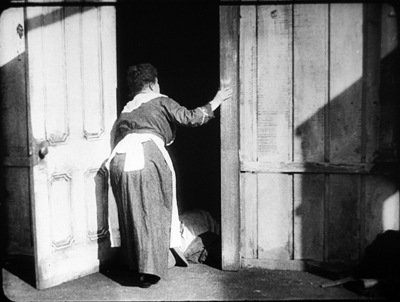
Cut 180 degrees again to a variant of the first shot, framing the bunkhouse in long shot. After a beat, Tom Blair and his horse appear in the foreground. The lighting here is of remarkable delicacy: the silhouettes are barely picked out.
We return to the shot inside the bunkhouse. Another beat: The face of the man passing emerges as she turns away in horror.
Tom mounts his horse and rides off. Soon, in another shot from outside, the ranch workers gather at the doorway, as Ben arrives with his horse. One standard option would be to have the dead man carried in, to have the men assemble around the body, and in clear light and shot/ reverse-shot, to show Ben issuing his orders. Instead, Rankin’s body lies blocking the threshold and all the action is played in the bright rectangle and made emphatic by axial cuts.
The first cut comes as Ben reacts to what has happened. He’s in darkness, with the cook and cowpokes watching.
Ben tells them to take care of Rankin: “Put up your guns, boys–This is my affair.”
When one of the men accuses him of trying to cover up for his father, Ben explodes and starts beating him. A cut in to a closer view shows him strangling the offender. As in later cinema, the abrupt cut accentuates the violence of Ben’s attack.
An axial cut back shows the victim protesting: “Let up–I didn’t mean it!” Ben shoves him aside and bends over the dead man sorrowfully.
The ranch hands carry Rankin’s body in. Ben is left in the doorway brooding on what he must do to avenge the death of his surrogate father.
Call it Fordian if you want. I wouldn’t object.
Given the fame of Dustin Farnum as a star at that moment, it seems fairly daring to subordinate a dramatic high point to this incisive visual design, with all the action squeezed into the doorway. Stance and gesture have replaced close-ups and facial reactions. The scene varies so much from the book that we might want to credit the scenarist, Julia Crawford Ivers. Ivers, who who had directed films herself, collaborated closely with Taylor on his projects. The cinematographer, perhaps Homer Scott (another Taylor mainstay and a significant DP before 1923), may also have had a big say in this virtuoso scene. The film could claim its “Lasky lighting” as typical of the Paramount brand.
All of Taylor’s surviving films I’ve seen are of interest; he’s clearly one of the more talented directors to give up the tableau and work in the continuity style that would define Hollywood. In particular, Ben Blair would definitely be worth reconstructing and restoring. The LoC print, while jumbled in its last two reels, is fairly complete, and the shots could be rearranged coherently. At the risk of spoilers, I wanted to share with you my discovery of this exciting piece of work. Taylor deserves to be remembered for more than his fate that night in February 1922.
Thanks again to the John W. Kluge Center for providing me a long stay at the Library of Congress. The Moving Image Research Center was my host, and so I’m grateful to Mike Mashon, Greg Lukow, Karen Fishman, Dorinda Hartmann, Josie Walters-Johnston, Zoran Sinobad, and Rosemary Hanes. They’re doing a wonderful job. Special thanks to Richard Koszarski for background on his Rivals program, and to Alan Gevinson for discussions of 1910s cinema generally and Taylor in particular.
Relevant to this entry is Kristin’s article is “The International Exploration of Cinematic Expressivity,” in Film and the First World War, ed. Karel Dibbets and Bert Hogenkamp (Amsterdam University Press, 1995), 65-85. She discusses American lighting practices of the period in The Classical Hollywood Cinema: Film Style and Mode of Production to 1960 (Columbia University Press, 1985), 223-227. See also Lea Jacobs’ article “Belasco, DeMille and the Development of Lasky Lighting,” Film History 5, 4 (December 1993), 405-418.
Some Taylor films are available on DVD. The most authoritative is the beautiful restoration of The Soul of Youth that’s included in Treasures of American Film Archives vol. III: Social Issues in American Film 1900-1934. Tom Sawyer is available in a fairly good copy, as is Huckleberry Finn, which doesn’t survive complete; it has played on TCM in a tinted version. Copies of Johanna Enlists and Nurse Marjorie are problematic but watchable.
Ben Blair was mostly liked in the trade papers, though Variety claimed that the film was “hardly up to the Paramount standard.” But using the same phrase, Manhattan’s Broadway movie theatre declined to show it. You wonder if the Sidwell rape scene had something to do with the decision. After some wrangling, the management cut it to two reels and “used it as ‘filler.'” Tastes do change.
On Taylor’s career, see Richard Koszarski, “The William Desmond Taylor Mystery,” Griffithiana 38/39 (October 1990), 253-56. The most authoritative reference on Taylor’s life is Bruce Long’s collection of clippings and commentary William Desmond Taylor: A Dossier (Scarecrow, 1991), from which my backlighting quotation comes (p. 162). Alan Gevinson’s filmography in Long’s book is the most comprehensive I know. Long also ran the online publication Taylorology, which offered exhaustive coverage and analysis of the murder.
Speaking of the murder, there’s enough material in books and online to keep aficionados busy for years. Whodunit? Since this entry is spoiler-filled, I’ll summon a lineup. The principal books on the case finger four suspects: Mary Miles Minter’s mother (favored by King Vidor, as reported by Kirkpatrick); Mary herself (Higham); a hitman for a drug gang (Giroux); and one of a trio of blackmailers (Mann). Long’s Dossier lists many errata in the first two of these. Of these, Giroux’s is the most sober and avoids High Tabloidese, as well as the confident reporting of the thoughts and feelings of people long dead. My own hunch is that too much evidence has been destroyed to permit a plausible conclusion.
Still, the Taylorologists have supplied fascinating information on what Hollywood culture was like at the period. It still astonishes me that celebrities like Taylor, Minter, and Edna Purviance could live without bodyguards and security, while Mabel Normand could just stroll down the street to buy a bag of peanuts. And all chroniclers agree that the studios kept a lid on an investigation that law enforcement conveniently botched.
A quick and entertaining overview of the scandal is Rick Geavy’s graphic novel Famous Players: The Mysterious Death of William Desmond Taylor (NBM, 2009).
Okay, I can’t refrain from going a bit sleazy too. Below is a drawing of the crime scene from a newspaper of the period.
P.s. 4 January 2021: Add Erle Stanley Gardner to the list of distinguished investigators of the crime. His “1922: William Desmond Taylor,” summarizing press reports and offering some speculative inferences, appeared in Los Angeles Murders, ed. Craig Rice (Duell, Sloan and Pearce, 1947), 83-119.
Thanks to Taylorology and The Silent Era.












